8 days with stays, meals, transfers, guided sightseeing in Thimphu, Punakha & Paro including Tiger’s Nest hike.
Bhutan
07 Nights / 08 Days
On Request
Feel free to reach out to us anytime to know more about our tour packages and customize your perfect getaway.
OR INQUIRY NOW
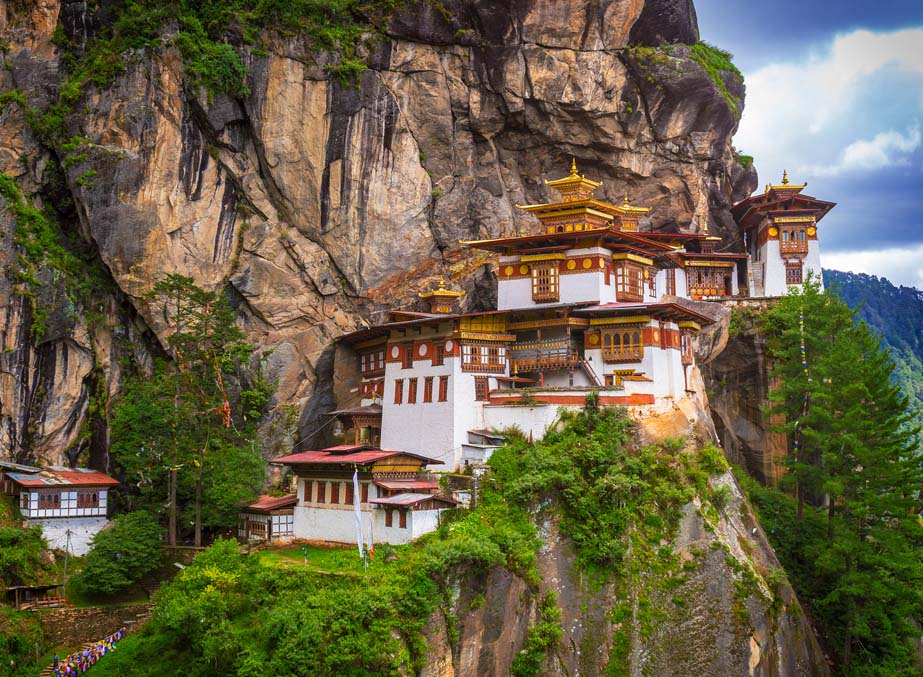
The flight to Paro stands as one of the most breathtaking experiences in the entire Himalayan region. This journey treats you to captivating vistas and an exhilarating descent into the Kingdom of Bhutan. As you step off the aircraft, Bhutan’s first welcome gift to you is the refreshingly cool and pristine mountain air.
Once you’ve completed immigration procedures and collected your luggage, our representative will extend a warm welcome, presenting you with a traditional ‘tashi khaddar’ – a white scarf symbolizing an auspicious reception for guests.
Following this heartfelt greeting, you will embark on a road journey to Thimphu, Bhutan’s capital town. The road takes you through the picturesque Paro valley, eventually leading to the convergence of the Paro and Thimphu rivers at a place called Chuzom.
As you approach Chuzom, you’ll notice Tamchog Lhakhang on your left. This temple, constructed by Thangtong Gyalpo, a pioneering engineer who introduced suspension bridge construction to Bhutan and Tibet (some of which are still in use today), is an intriguing sight. The present bridge to Tachog Lhakhang was meticulously restored in 2005, following traditional design with iron chains. Crossing this iron bridge is a delightful experience, and if you want you can enjoy a roundtrip walk lasting approximately 50 minutes.
Upon arrival in Thimphu, we settled into our hotel. As the capital of Bhutan, Thimphu stands as a vibrant hub of government, religion, and commerce, boasting a unique blend of modern development intertwined with ancient traditions. Notably, it remains one of the few capital cities in the world without a single traffic light.
In the afternoon, visit National Memorial Chorten, a striking white structure topped with a gleaming golden spire. Situated near the heart of Thimphu, this monument stands as an emblematic landmark, drawing locals and visitors alike. Here, amidst the bustling atmosphere, one can engage with locals as they perform the sacred circumambulation, spin the crimson prayer wheels, and offer prayers at the modest shrine within the gate. The intricate paintings and statues within the chorten offer profound insights into Buddhist philosophy.
Later visit to Trashichhoedzong, often referred to as the ‘fortress of the glorious religion.’ This remarkable edifice serves as the heart of both government and religion in Bhutan, housing the monarch’s throne room and serving as the seat of the Je Khenpo, or Chief Abbot. Originally constructed in 1641 by Bhutan’s political and religious unifier, Zhabdrung Ngawang Namgyal, it underwent a meticulous reconstruction in the 1960s, employing traditional Bhutanese construction methods that eschewed the use of nails or architectural plans.
Overnight at the hotel in Thimphu (Altitude 2,320m).
Following breakfast, make a brief drive north of the town to reach Buddha Dordenma, situated atop a hill within the serene Kuenselphodrang Nature Park. This remarkable statue brings to life an ancient prophecy originating from the 8th century A.D., which was unearthed by Terton Pema Lingpa, a discoverer of religious treasures. It is believed that this statue emits an aura of tranquillity and joy, extending its influence to the entire world. Crafted from bronze and adorned with a layer of golden gilding, this colossal Shakyamuni statue stands at a towering height of 51.5 meters, solidifying its position as one of Bhutan’s largest statues. Within the Buddha Dordenma statue itself, an astonishing 125,000 smaller Buddha statues, also cast in bronze and gilded, have been meticulously arranged.
Then embark on Buddha Dordenma to Changangkha Lhakhang (approx. 1.1/2-hour, easy walk). As you move on this trail, you’ll be greeted by a magnificent sight of hundreds of prayer flags waving in the breeze, creating a colourful and spiritual welcome. The trail leads you through a pristine forest adorned with tall pines, graceful birch trees, and vibrant rhododendrons. Entire trail is well-maintained and along the way, you’ll come across charming gazebos, providing perfect vantage points.
Visit Changangkha Lhakhang, an ancient temple holding a rich history and dating back to its establishment by Lama Phajo Drugom Shigpo. This revered Lama, hailing from Tibet, is regarded as the founder of the Drukpa lineage in Bhutan. The temple’s construction began in the 12th century and was further extended by his son in the 13th century. At the heart of Changangkha Lhakhang resides a central statue of Chenrezig, a manifestation with eleven heads, representing compassion and enlightenment. For generations, parents have journeyed here to seek blessings for their newborns from the protector deity Tamdrin. Children are blessed with a phurba, a ritual dagger, and adorned with a sacred thread as part of this cherished tradition.
Before heading for lunch, visit Takin Preserve, more commonly referred to as the Motithang Zoo. This sanctuary is dedicated to the conservation of the Takin, Bhutan’s national animal, a highly uncommon mammal belonging to the ovine-carpine family.
Bhutan has gained recognition for its inventive postage stamps, and The Postal Museum offers a glimpse into the evolution of postal services and, to some extent, the communication system within the country. It also showcases Bhutan’s collection of rare and unique stamps that have been issued over the years. Additionally, you can pay a visit to the Postal office, conveniently situated next door, where you have the opportunity to create personalized postal stamps and explore a variety of souvenirs.
Continue onto Textile Museum, a cultural gem that beautifully encapsulates Bhutan’s rich heritage in the realm of textiles. Under the patronage of Her Majesty Queen Ashi Sangay Choden, this museum has elevated Bhutanese textiles to an art form of profound significance. Its exhibits are a captivating journey through six major themes, including warp and weft pattern weaves, the role of textiles in religion, outstanding achievements in textile arts, textiles sourced from indigenous fibers, and a glimpse into the Royal collection. Through intricate weavings and vibrant designs, the Textile Museum offers visitors a deeper understanding of Bhutan’s cultural tapestry and the intricate craftsmanship that has been a hallmark of the nation for centuries.
Afterwards, drive to Zilukha Nunnery. Built in 1976 by the 16th emanation of Thangtong Gyalpo, Drubthob Rikey Jadrel, this is the only nunnery in the capital city of Thimphu. Located above Zilukha Lower Secondary School, overlooking Traschichhoedzong, the nunnery is home to about 60 nuns who lead life of spiritualism, prayer and meditation.
Evening an exploratory walk around Thimphu city centre. You may also explore Ka Ja Throm. Previously known as the Centenary Farmers Market (CFM), Kaja Throm marks a significant transformation in Thimphu’s urban landscape and designated as the Market Quarter where leisure, culture, knowledge, employment, and tourism economies converge. The upgraded Kaja Throm is a vibrant and bustling market centre where the modern and traditional elements of Bhutanese life converge. Whether you’re seeking local handicrafts, farm products, savour local cuisine or simply a place to soak in the atmosphere, Ka Ja Throm provides a quintessential Thimphu experience. With its wide assortment of products and its picturesque and colourful setting, Kaja Throm is one of a favourite spot for tourists too.
Overnight at the hotel in Thimphu (Altitude 2,320m)
After breakfast, drive up to Dochu-la pass (3,088m/ 10,130 ft) stopping briefly here to take in the view and admire the chorten, mani wall, and prayer flags which decorate the highest point on the road. If skies are clear, the following peaks can be seen from this pass (left to right): Masagang (7,158m), Tsendagang (6,960m), Terigang (7,060m), Jejegangphugang (7,158 m), Kangphugang (7,170 m), Zongphugang (7, 060 m), a Table Mountain that dominates the isolated region of Lunana – finally Gangkar puensum, the highest peak in Bhutan at 7,570m.
At Dochula Pass, 108 chortens or stupas known as Druk Wangyal Chortens have been built by Ashi Dorji Wangmo Wangchuk, the eldest Queen Mother. These chortens are built in three layers, the first lowest level layer has forty-five chortens, the second has thirty-six and the top layer has twenty-seven, built around the main chorten.
Then drive onto Gangtey, passing through dense forests of oak and rhododendron tress.
The valley of Gangtey is one of the most beautiful and unspoiled places in Bhutan. The surprise of finding such a wide, flat valley without any trees after the hard climb through dense forests is augmented by an impression of vast space and is an extremely rare experience in Bhutan where most of the valleys are tightly enclosed. A few kilometers beyond the Gangtey Monastery, on the valley floor lies the village of Phobjikha.
Afternoon explore fascinating Phobjikha valley. This place is the winter home of black necked cranes that migrate from the arid plains in the north to pass winter in milder and lower climate. The valley boasts two beautiful meandering rivers, Nakay Chhu (Chhu Naap-black water) and Gay Chhu (Chhu Karp-white water).
Also visit Black Neck Crane Information Centre. Situated on the edge of the forest and wetland along the main road of Phobjikha valley, the black-necked crane information Centre has an observation room equipped with high power telescope and spotting scopes for catching the best view of the cranes. The centre also offers display information that outline the natural and cultural history of the area. There is a small gift shop, which sells handicrafts produced by the local people.
Overnight at the hotel in Gangtey (Altitude 3,000m).
After breakfast visit Gangtey Goenpa (monastery). Perched on a small hill that rises from the valley floor, the Gangtey Monastery is the only Nyingmapa monastery on the western side of the Black Mountain’s and also the biggest Nyingmapa monastery in Bhutan. The Monastery is surrounded by a large village inhabited mainly by the families of the 140 Gomchens who take care of the Monastery. Gangtey was founded by Pema Trinley, the grandson of Pema Lingpa, the famous Nyingmapa saint of Bhutan. In 1613, Pema Trinley establish the monastery and became the first Gangtey Tulku. The religious traditions of Pema Lingpa still taught there. The second Tulku, Tenzin Legpa Dondrup (1645 to 1726), enhanced the size of Gangtey while keeping up good relations with Drukpas, and rebuilt the monastery in the form of a Dzong.
Then proceed a pleasant walking excursion on Gangtey Nature Trail. This pleasurable walk will give you a nice feel of Phobjikha valley. From the small hilltop overlooking Gangtey Goenpa, you head downhill through flower meadows to Semchubara village and from here through beautiful forests and into the open valley. The trail ends at local community school after passing a chorten and Khewa Lhakhang. (approx. 5.5km, 2 hours walk).
After lunch, drive onward to Punakha. Before entering Punakha town, on the way visit to Wangduephodrang Dzong. Founded by Zhabdrung Ngawang Namgyal in 1638, on the top of high ridge between Punak Tsang Chhu and Dang Chhu rivers, offering fantastic of the valley below, Wangdue Dzong holds special place in Bhutan’s history. The strategic location of the dzong, provided Penlop (Governor) of Wangduephodrang, chance to protect the routes to Trongsa, Punakha, Dagana and Thimphu making him the third most powerful ruler after Governors of Paro and Trongsa. The Dzong had been damaged by fire in 2012 and restored to its original grandeur and splendour recently (in 2022).
Punakha served as the capital of Bhutan and seat of government until 1955 and still it is the winter seat of Je Khenpo (the chief abbot). Blessed with temperate climate and owing to its natural drainage from Pho Chhu (male) and Mo Chhu (female) rivers, the fertile Punakha valley produces abundant crops and fruits. Located at an elevation of 1300m above sea level, Punakha enjoys mild winters and is popular year-round destination.
Overnight at the hotel in Punakha (Altitude 1,300m).
After breakfast, a beautiful hike takes one to the regal Khamsum Yuelley Namgel Chorten, which was built to remove negative forces and promote peace, stability and harmony in the changing world. The Chorten dominates the upper Punakha Valley with commanding views across the Mo Chhu and up towards the mountainous peaks of Gasa and beyond.
After lunch, visit Punakha Dzong or (Palace of Great Happiness), built at the junction of the Phochu and Mochu rivers in 1637 by Zhabdrung Ngawang Namgyal. This majestic dzong served as both the religious and the administrative centre of Bhutan in the past. It measures some 600 by 240 feet and has a six-story, gold-domed tower. Inside are courtyards and religious statuary that hint at the depth of history and spiritual tradition embodied here. Your guide will illuminate your understanding of this intricate culture that is exotic to us, though long established here.
Then a short excursion to Chimi Lhakhang.
The Chimi Lhakhang, situated on a hillock in the centre of the valley, also known as the temple of fertility. It is widely believed that couples who do not have children and wanting one, if they pray at this temple, they are usually blessed with a child very soon. The trail leads across rice fields to the tiny settlement of Pana, meaning ‘field’. A walk through the village near the temple will give you rare glimpses into the daily life and lifestyle of the villagers.
Evening explore newly developed Wangdue town and its local market.
Overnight at the hotel in Punakha (Altitude 1,300m).
After breakfast, drive to Paro along scenic highway.
On arrival in Paro, check into the hotel.
The beautiful valley of Paro encapsulates within itself a rich culture, scenic beauty and hundreds of myths and legends. It is home to many of Bhutan’s oldest temples and monasteries, National Museum and country’s only international airport. Mount. Chomolhari (7,314m) reigns in white glory at the northern end of the valley and its glacial water plunge through deep gorges to form Pa Chhu (Paro River). Paro is also one of the most fertile valleys in the Kingdom producing a bulk of the locally famous red rice from its terraced fields.
Post lunch, proceed to visit Ta Dzong, originally built as Watchtower, which now houses National Museum. The extensive collection includes antique thangkha paintings, textiles, weapons & armour, household objects and a rich assortment of natural and historic artifacts.
Ta Dzong visit immediately followed by a short walk down the trail to visit Rinpung Dzong (Paro Dzong), meaning (“fortress of the heap of jewels”), which has a long and fascinating history. Along the wooden galleries lining the inner courtyard are fine wall paintings illustrating Buddhist lore such as four friends, the old man of long life, the wheel of life, scenes from the life of Milarepa, Mount. Sumeru and cosmic Mandala.
Walk in to visit a traditional farmhouse. These charming structures, often adorned with intricate woodwork and painted in vibrant colors, are a testament to Bhutan’s architectural heritage. Visitors have the opportunity to experience the warmth of Bhutanese hospitality, savor authentic local cuisine, witness traditional farming practices, and immerse themselves in the tranquil ambiance of the countryside. It’s a unique and enriching way to connect with the traditions and way of life that have endured for generations in this picturesque region of Bhutan. Here you’ll also have opportunity to try your hand in Archery using traditional bamboo bow & arrow. Archery is Bhutan’s national sport and integral part of all special occasions.
Conclude your day with a comfortable overnight stay at the hotel in Paro, situated at an altitude of 2,280 meters.
Following breakfast, embark on a captivating journey to Taktshang Monastery, also known as Tiger’s Nest, which involves approximately a 5-hour round-trip hike. This monastery holds a position of utmost prominence among Bhutan’s monastic institutions, clinging to the side of a cliff at an elevation of 900 meters above the Paro valley floor. Legend has it that Guru Rinpoche arrived at this sacred site on the back of a tigress and engaged in meditation, hence earning it the name ‘Tiger’s Nest.’ Recognized as one of the most sanctified places in Bhutan, it was visited by Zhabdrung Ngawang Namgyal in 1646 and is now a pilgrimage site frequented by all Bhutanese at least once in their lifetime.
OR if you are not interested in Tiger’s Nest Hike
After breakfast, driving excursion to Chelela pass.
Chele la (pass), at an elevation 3,988 meters is considered to be one of the highest motorable passes in Bhutan. About an hour’s drive along a thickly forested road, is this Pass-a botanical paradise. The pass provides stunning views of the sacred mountain Jomolhari and Jichu Drake. It is also marked by hundreds of prayer flags fluttering in the wind. During season, here visitors can see cascades of wild roses, purple and yellow primulas, and swathes of deep blue iris covering the forest floor. The top of the pass bloom with rhododendrons in a variety of colours-pale pink, deep pink, burnt orange, mauve, white and scarlet, in season.
Evening at leisure in Paro city centre, exploring charming, petite shops selling wide range of handicrafts and local farm products. Overnight at the hotel in Paro. (Altitude 2,280m)
After breakfast, transfer to the airport for flight to onward destination.
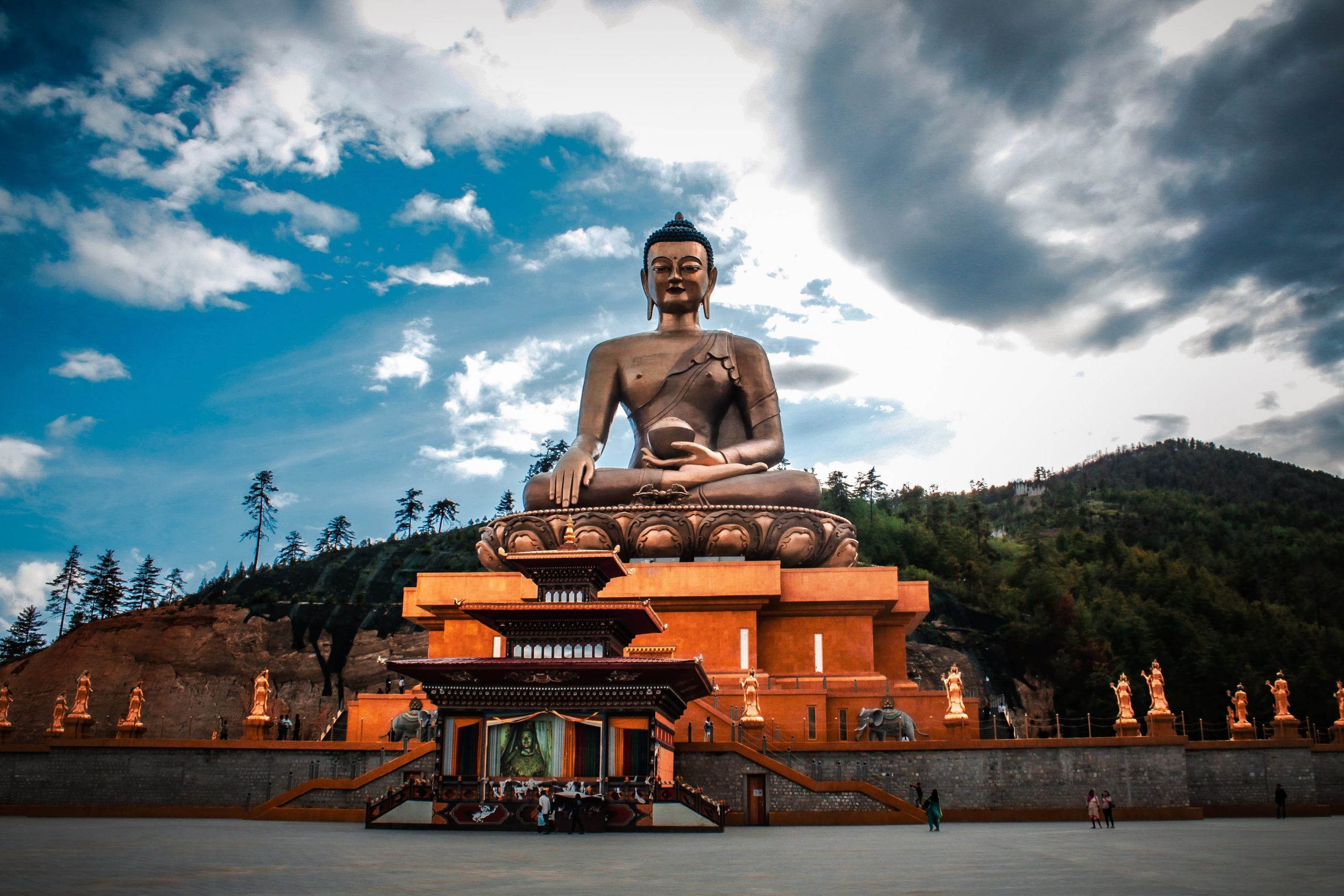
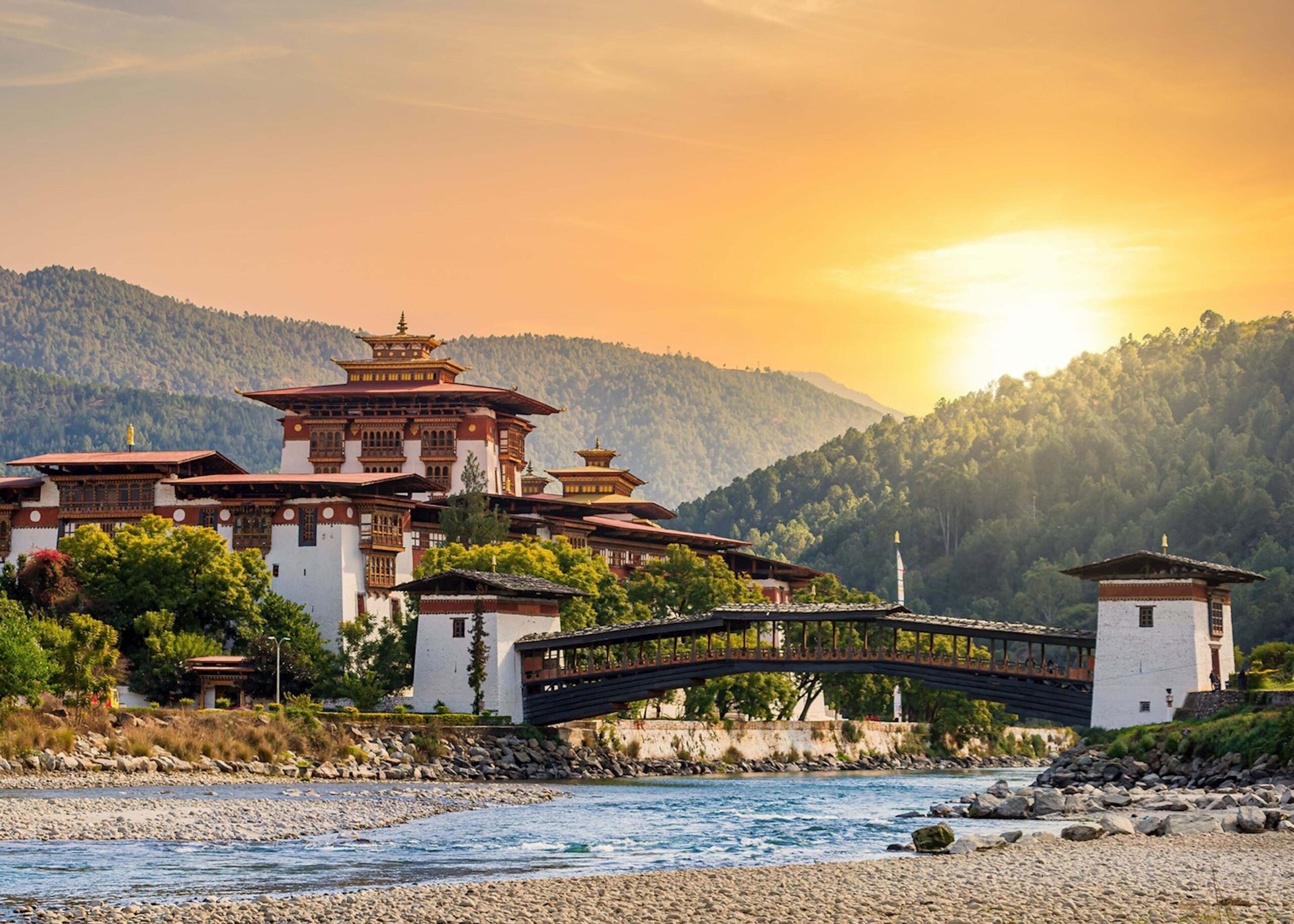
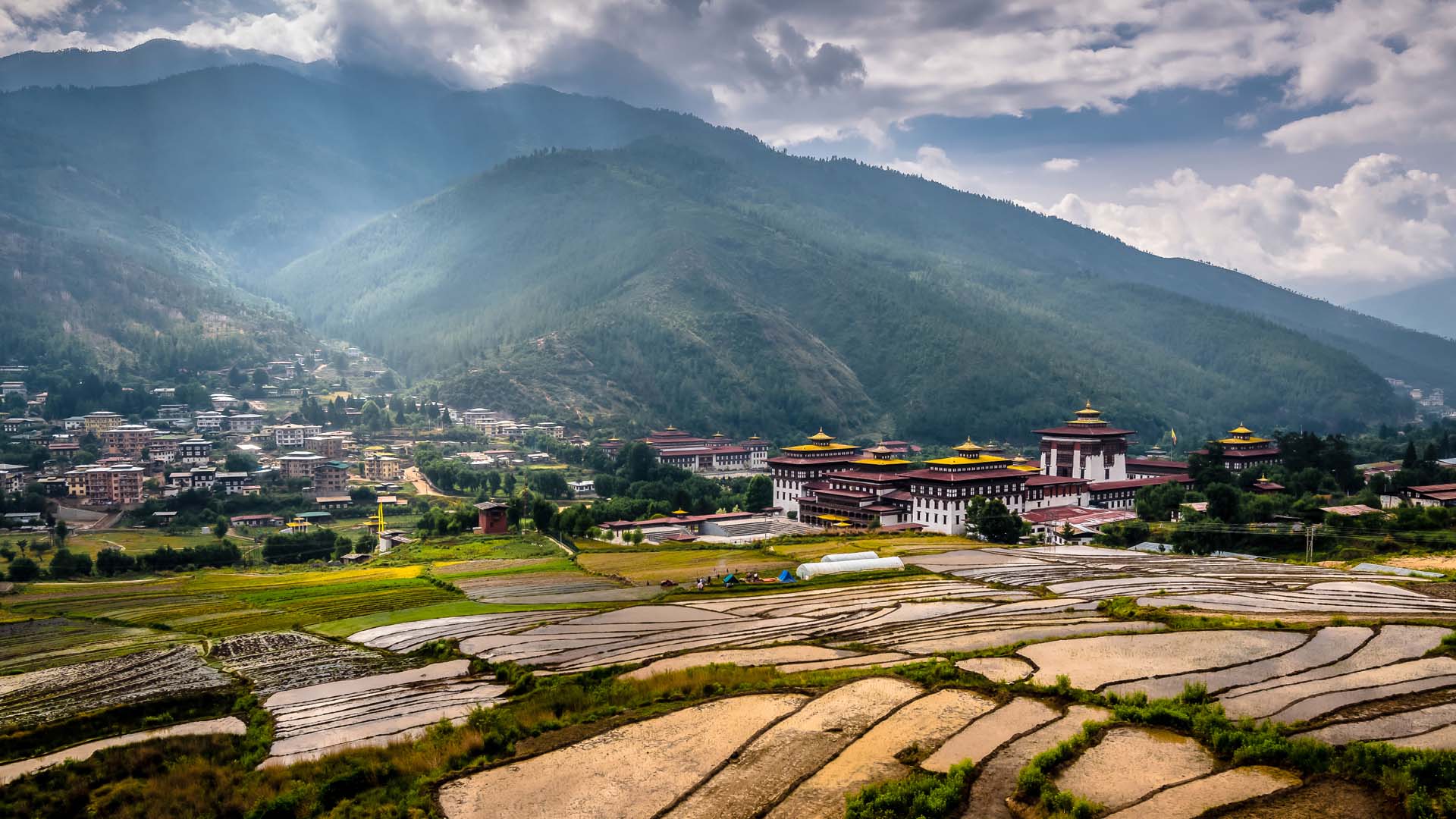
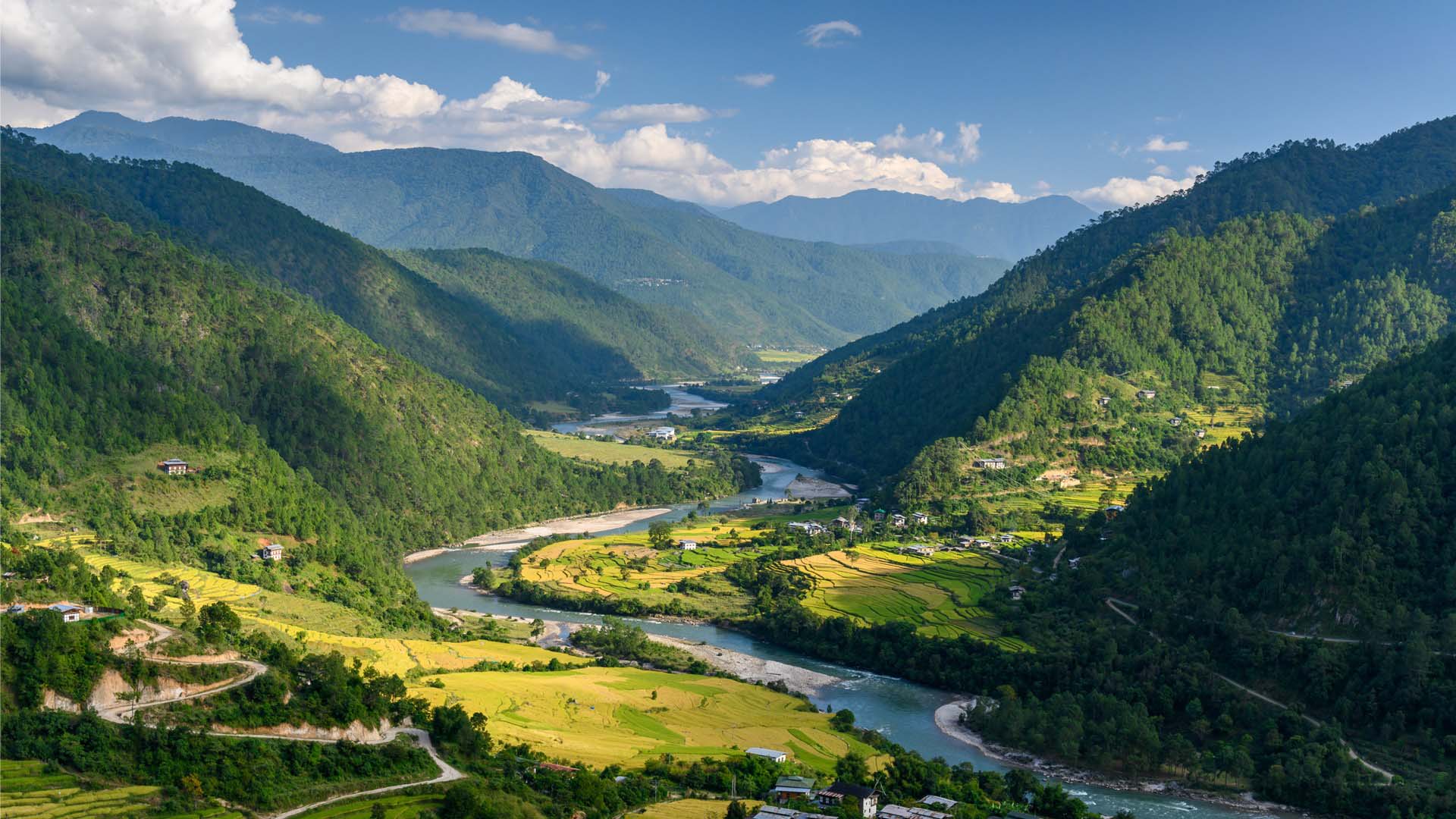
Reach out today to unlock exclusive travel deals and personalized support. Whether you’re dreaming of a world tour or a local escape, we’re here to make it unforgettable.
A: Trivandrum, Kerala, India
Created by Phoenix Creatives
Copyright © 2025. All rights reserved by India Tour Designer